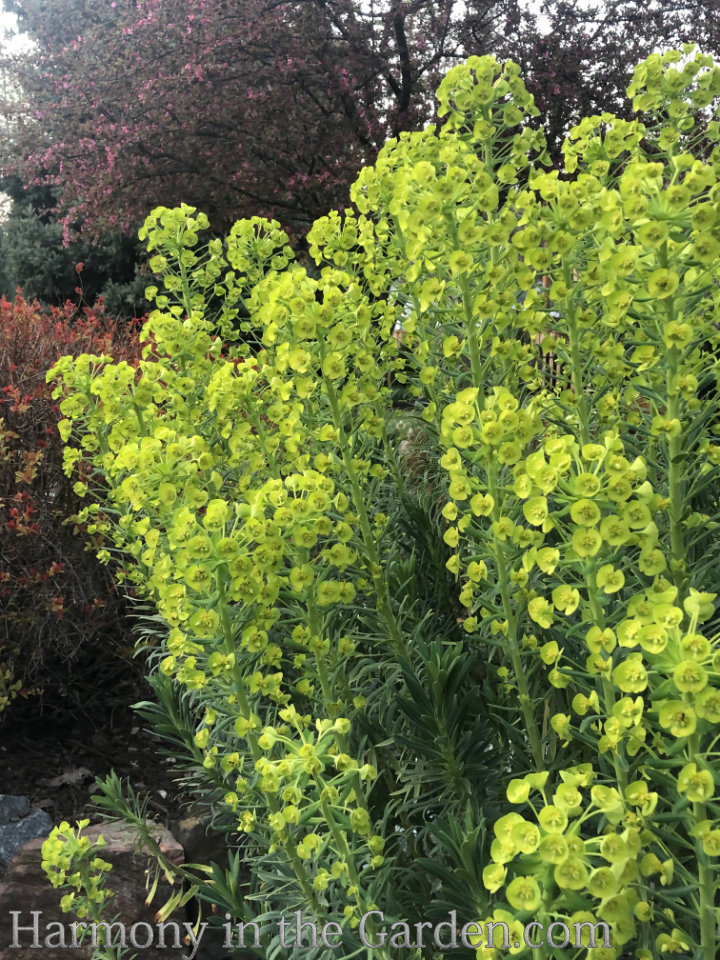
In early spring, it’s safe to say I’m in a state of ‘euphorbia euphoria.’
Clusters of otherworldly chartreuse flowers hover above many other perennials just emerging from winter, bringing much-needed color and nectar for hungry pollinators.
But their flowers are just one of the many reasons they’re a staple in my zone-9 garden.
They’re also extremely drought and heat-tolerant, surviving on very little water even during the hottest summer months (and where I live, it’s HOT. We just had close to 30 straight days of triple-digit temps!)
Euphorbias are also awful tasting to gophers, deer & rabbits (thanks to their irritating sap).
One crucial aspect to remember is that most euphorbias are very sensitive to over watering and wet-feet. It’s vital that they have fast drainage to prevent root rot, which is the #1 cause of death.
If you think your soil has too much clay, I’d recommend throwing a few handfuls of garden grit in the bottom of the hole (click here to see what I use).
Below are some of my favorite varieties of euphorbia and the different ways I design with them.
1. Create Unusual Color Echoes
In my book, Refresh Your Garden Design with Color, Texture and Form, I write a lot about using a plant’s subtle details to create unusual color echoes in the garden. Euphorbias are some of my favorites to use for this purpose.
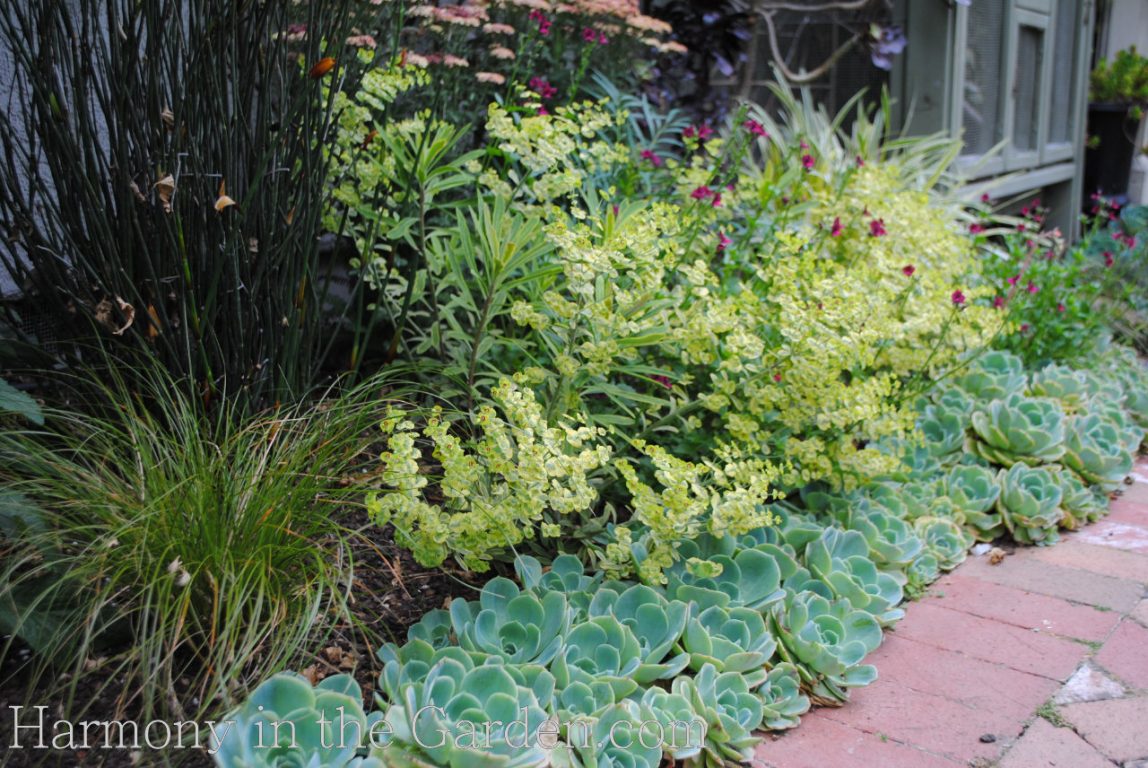
Euphorbia martinii ‘Ascot Rainbow’ zones 6-9
Not only are the stems and foliage of this variety tinged with soft shades of pink and yellow, but its flower bracts are just as colorful.
In fact, the flower’s blue variegation and raspberry-colored ‘eye’ inspired the pairing of it with nearby echeveria imbricata (Hens n Chicks) and a magenta-colored nemesia.

This lovely little euphorbia, grows to a manageable 2’x2′, making it an ideal choice for the front of a border.
As is common with many variegated plants, ‘Ascot Rainbow’ appreciates a little afternoon shade to prevent burning.
The internet says its USDA zones are 7-9, ‘but Ascot Rainbow’ has shown remarkable adaptability in our Lake Tahoe zone 6 garden, thriving even after being buried by 10-feet of snow. What a fantastic surprise!
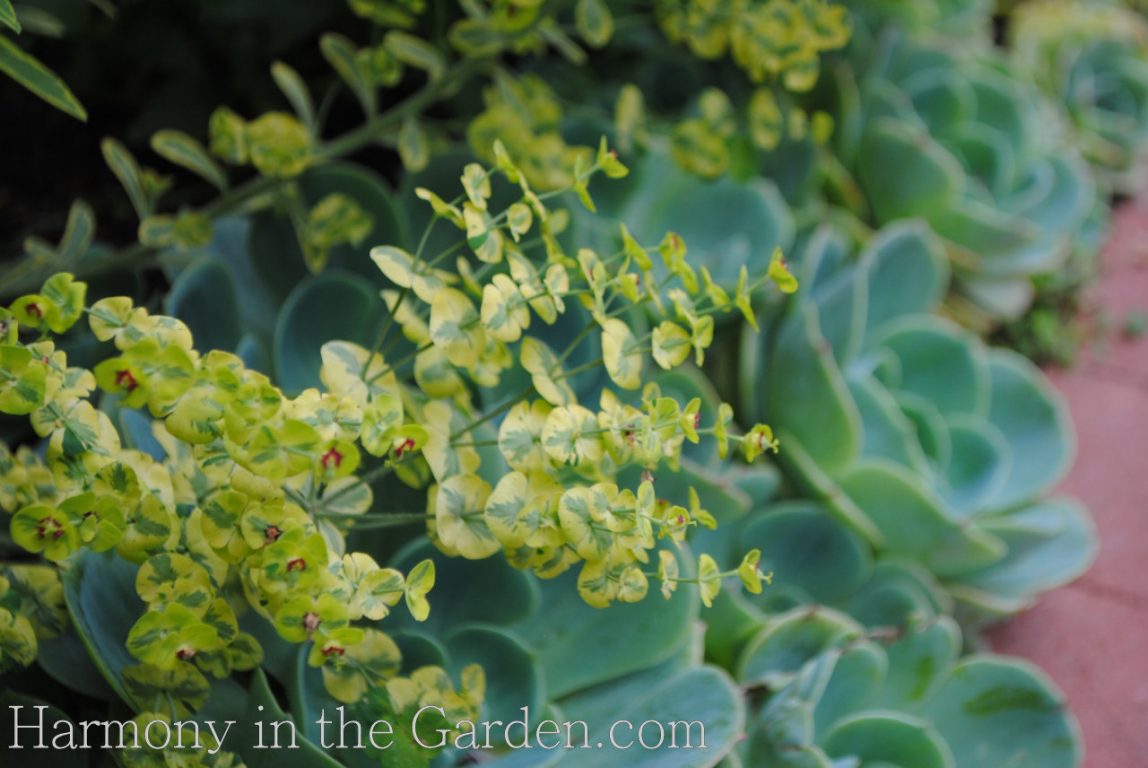
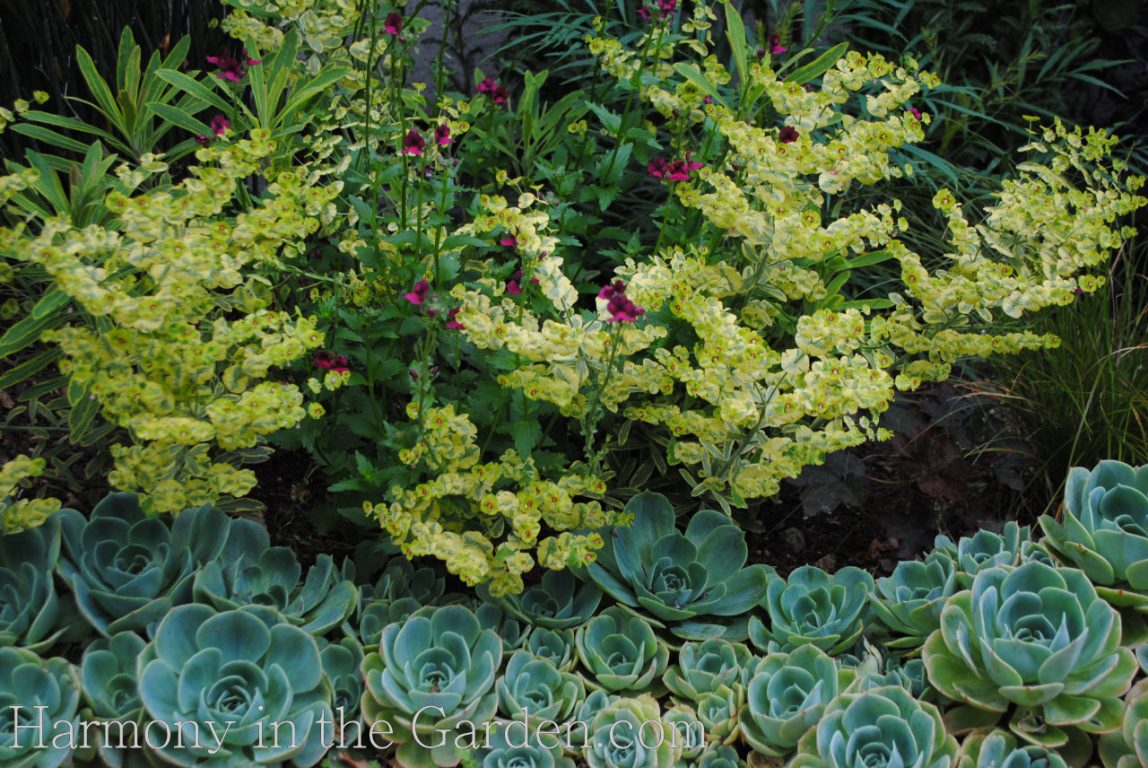
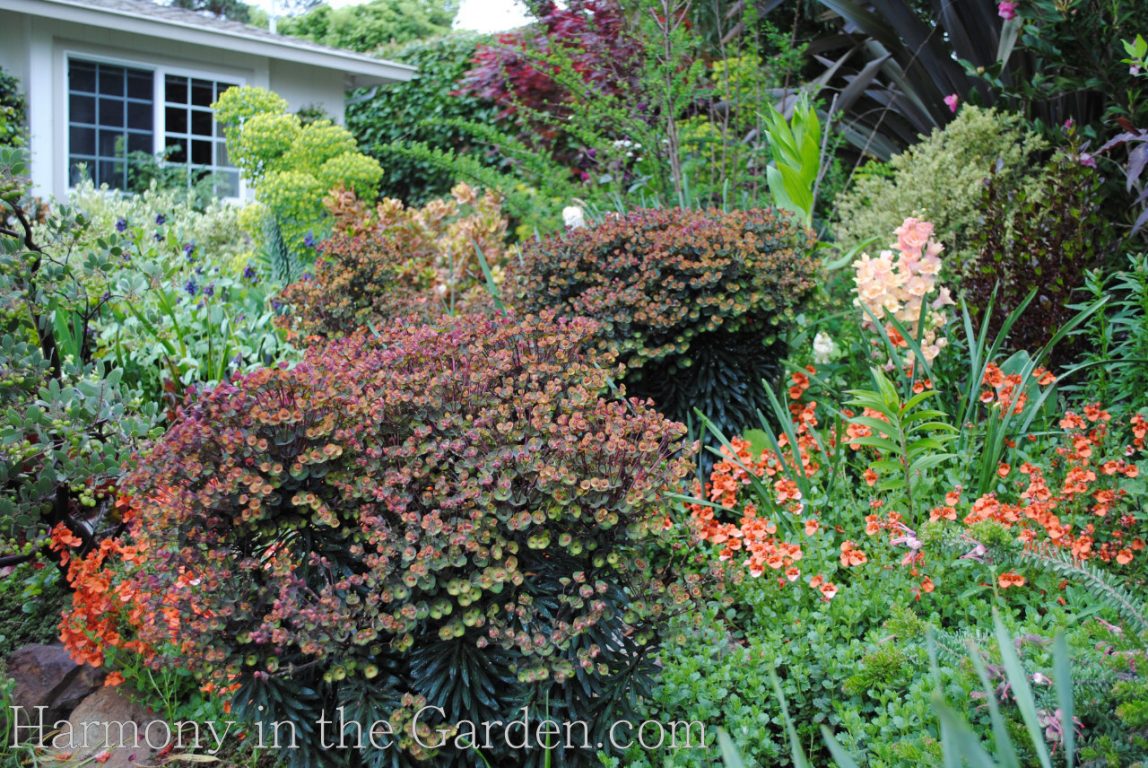
Euphorbia amygdaloides ‘Purpurea’ zones 5-9
This is another favorite euphorbia for creating color echoes, as the softer shades of burgundy change throughout the year from maroon to a soft olive green.
As if that isn’t enough, the flowers will emerge in early spring in shocking shades of chartreuse, which add much-needed color to a newly emerging garden.
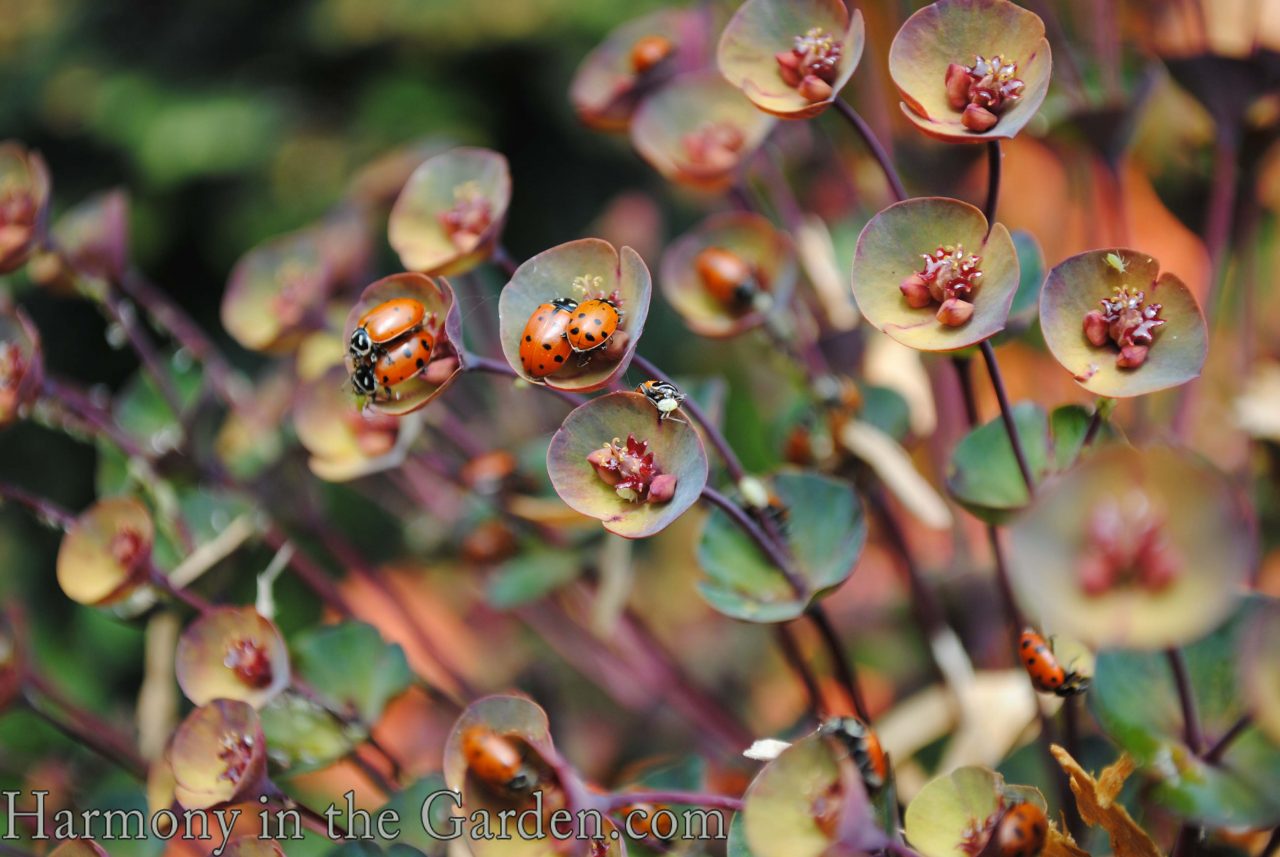
In the above bed, I pulled out the dark peachy-coral colors from the aging flower bracts and echoed them with surrounding heuchera ‘Peach Flambe’ and Antirrhinum majus ‘Chantilly Peach’ (from Annie’s Annuals).
Oh, and did I mention that ladybugs ADORE the flowers?
That’s because aphids sometimes hide in the tiny flower bracts, but luckily, they’re no match for the ladybugs.
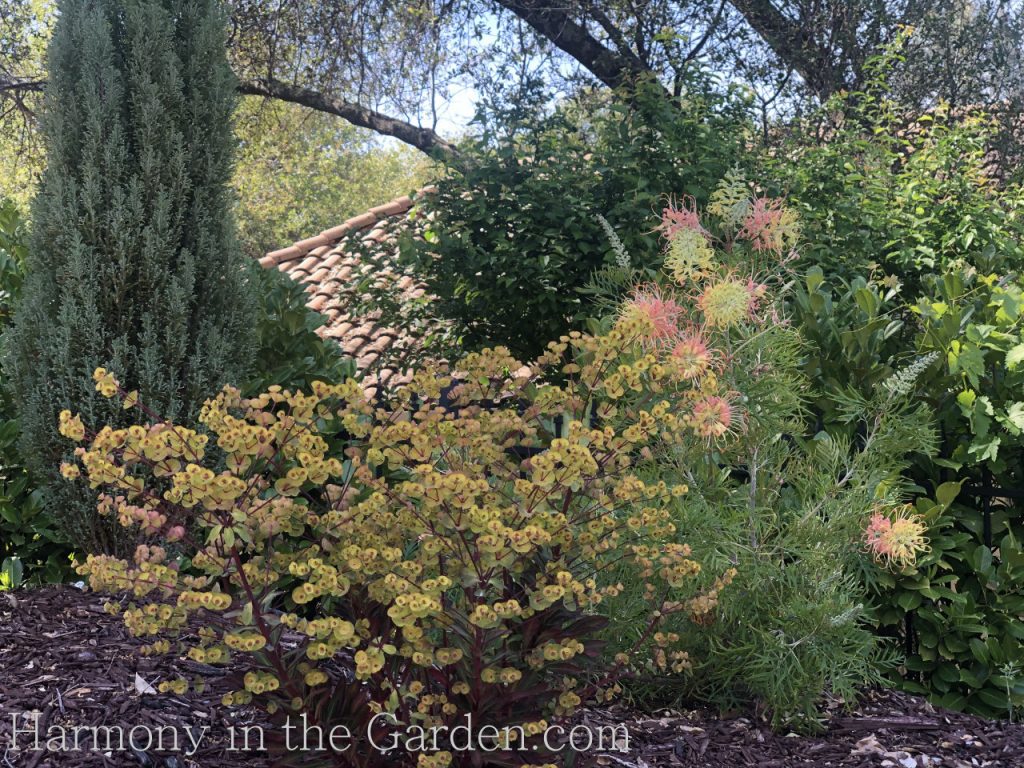
Euphorbia ‘Miner’s Merlot’ zones 6-9
‘Miner’s Merlot’ is another 2’x2′ variety that I’ve recently planted in my new garden, and I think I love it even more than the ‘Purpurea’ above.
It has some of the darkest burgundy foliage I’ve seen, with flowers that mature to beautiful gold-caramel colors.
In this part of my garden, I’ve paired it with a grevillea ‘Peaches & Cream’ to highlight the soft yellow and gold tones (click here to read more about gorgeous grevilleas!)

Euphorbia rigida, zones 7-10
This evergreen perennial grows upright with very stiff foliage and stems (hence its name ‘rigida’!) to about 2’x 3’.
And while its steely blue-green foliage stands out in this garden, when planted among the variegated westringia and dark green rosemary, take a look below at the flowers!
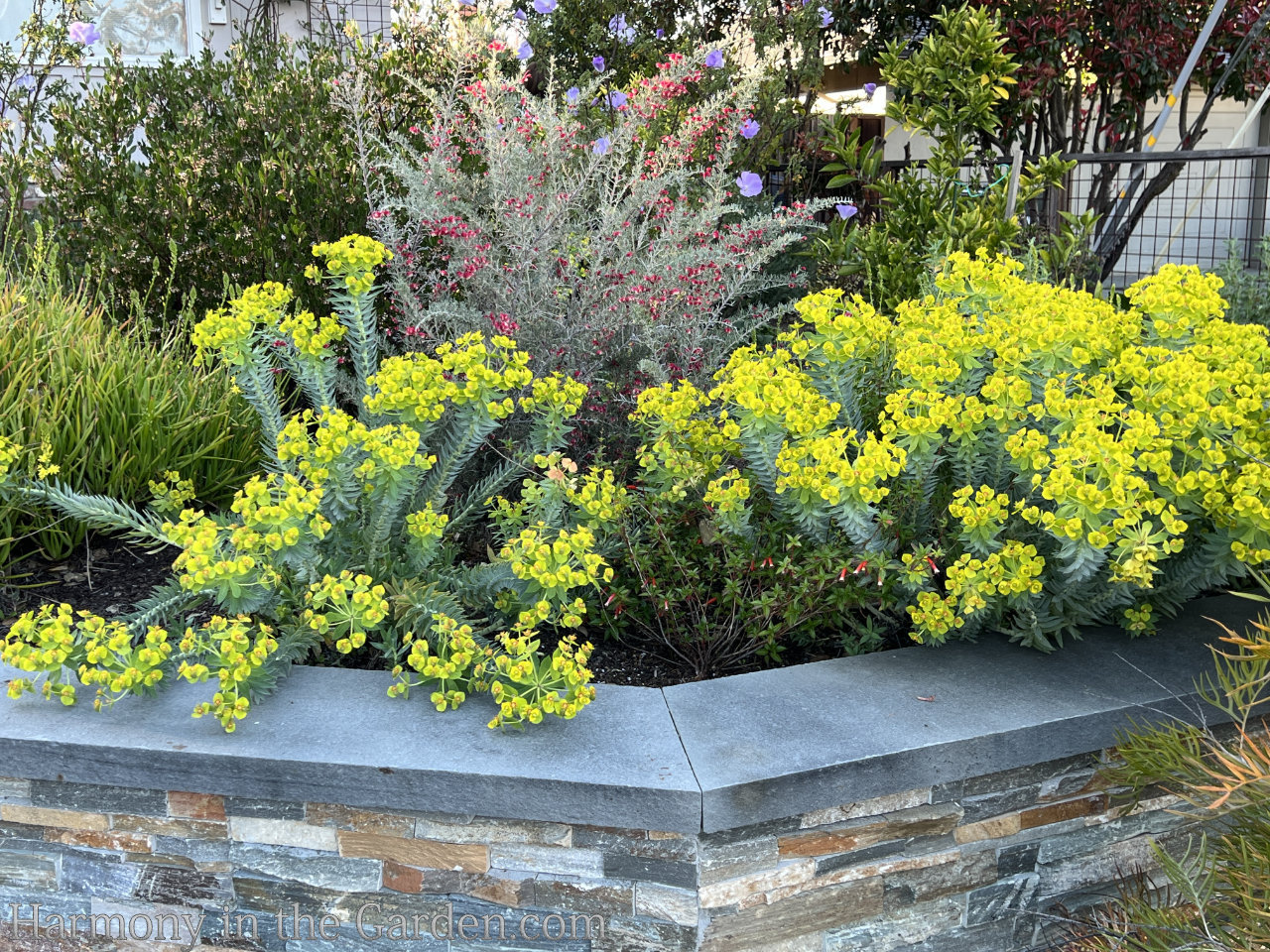
When in bloom (starting spring thru early summer) the acid-yellow flowers are held aloft on its stiff upright stems.
Click here if you’d like to read more about this sloping garden (with some pretty fantastic before and after photos!)
2. Add Motion Using a Plant’sForm
Another elusive element in the garden is visual motion. I’m not talking about literal motion, like swaying grass on a windy day, but a plant that gives the illusion of movement without any breeze whatsoever
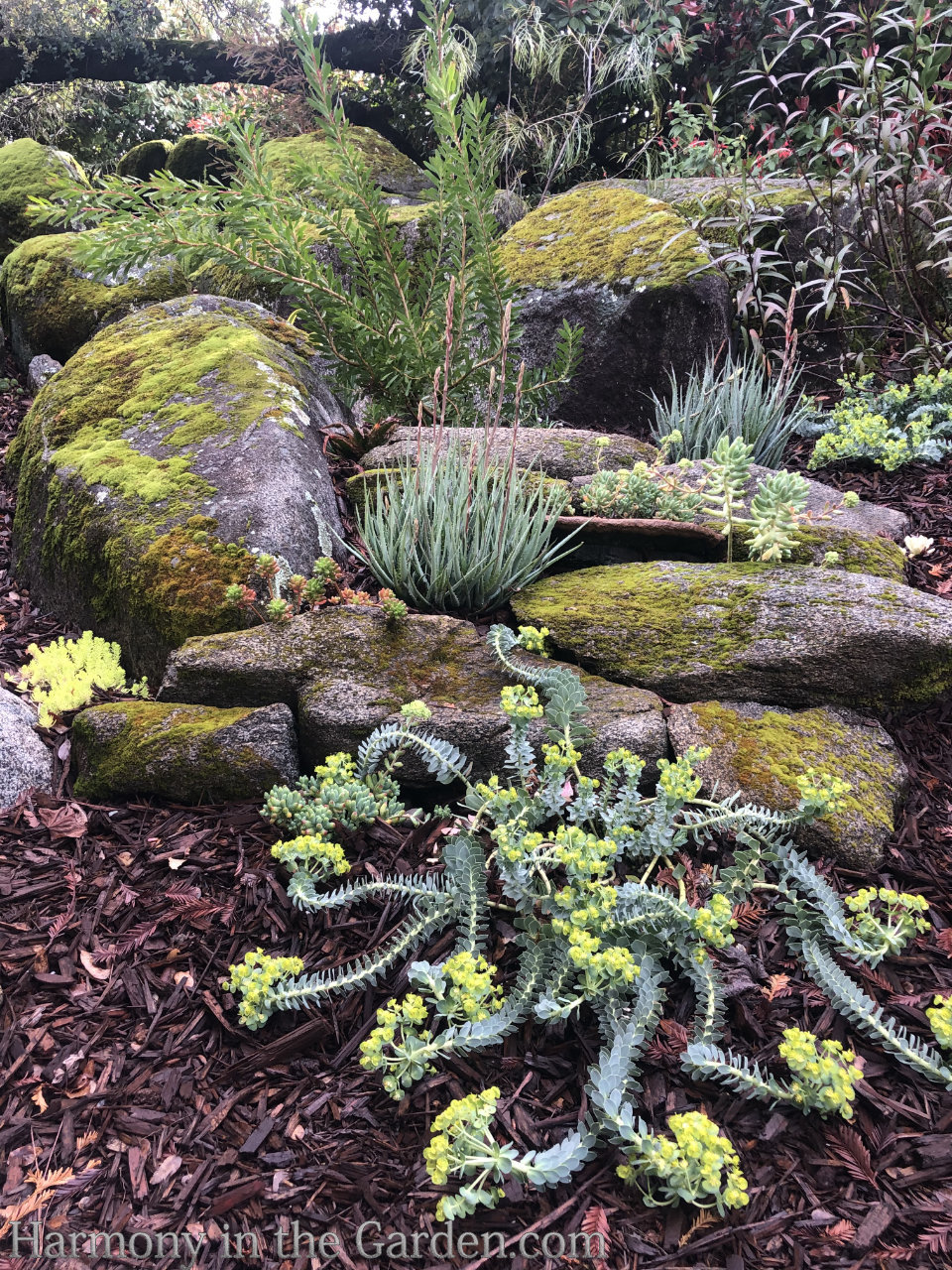
Euphorbia myrsinites, zones 4-9
This one of my favorites to add visual motion to the garden, creating twirly excitement wherever you plant it.
Sprawling to just 1′ x 3′, its perfect cascading over a stone wall.
Once the blooms are spent, prune them to the ground. They’ll quickly push out new growth throughout the year.
It’s a super tough variety, thriving in the hottest conditions as well as freezing temps. I’ve even seen it growing without any additional water in a neglected parking lot in Nevada’s high-desert area, a testament to its resilience.
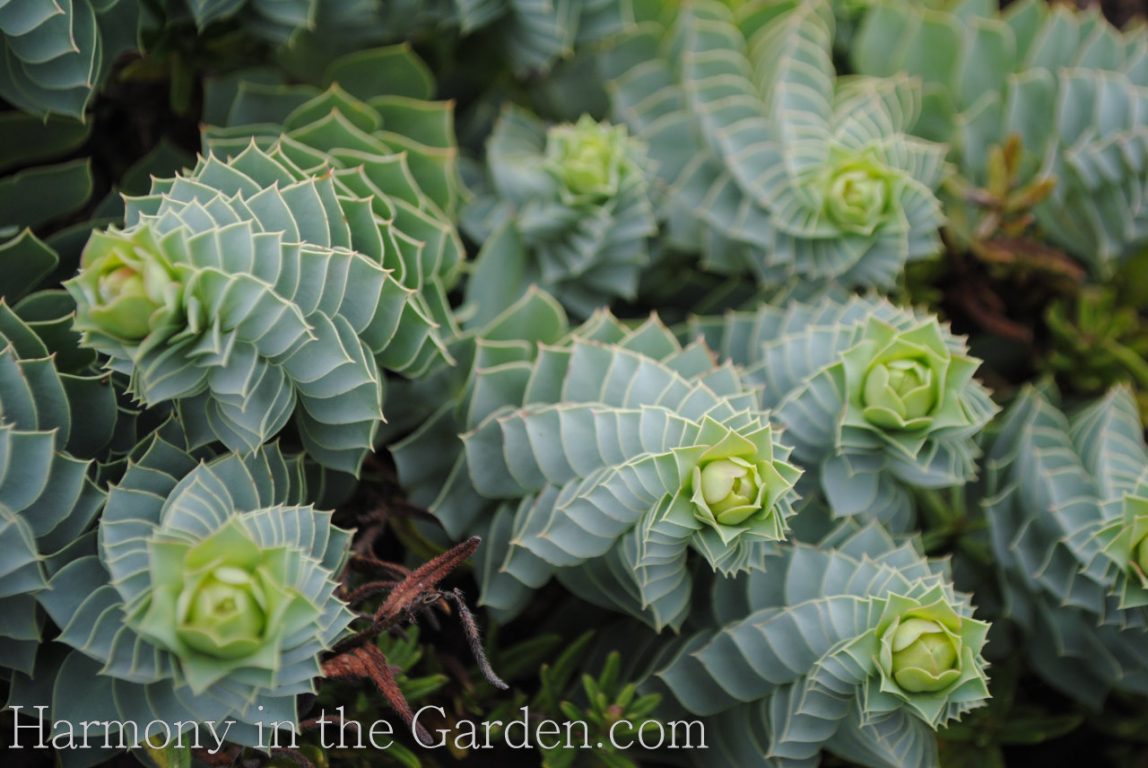

I love using this variety in window boxes, too, as it’s much easier to see the cascading flowers when they’re at eye level.
In fact, if you click here, you can see both the euphorbia myrsinites and the euphorbia ‘Ascot Rainbow’ in two different window box combinations!
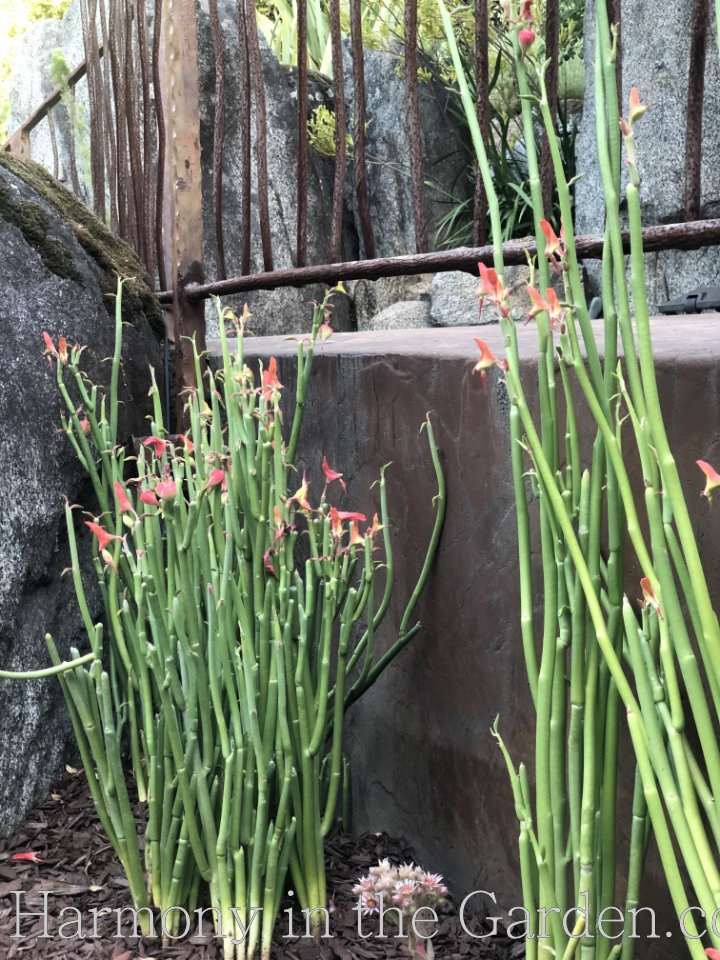
Euphorbia lomelii zones 9-11
Perfect for tight spaces, the euphorbia lomelii (also called the Slipper Plant) makes an ideal choice.
It grows upright to 6′ high by 2-3′ wide and looks great every day of the year.
Blistering sun, temps in the low 30’s, very little water – no problem at all for this euphorbia.
And in case you’re wondering why it’s called the ‘Slipper Plant’ – just take a look at the flowers!
Very cute, and kids love this.

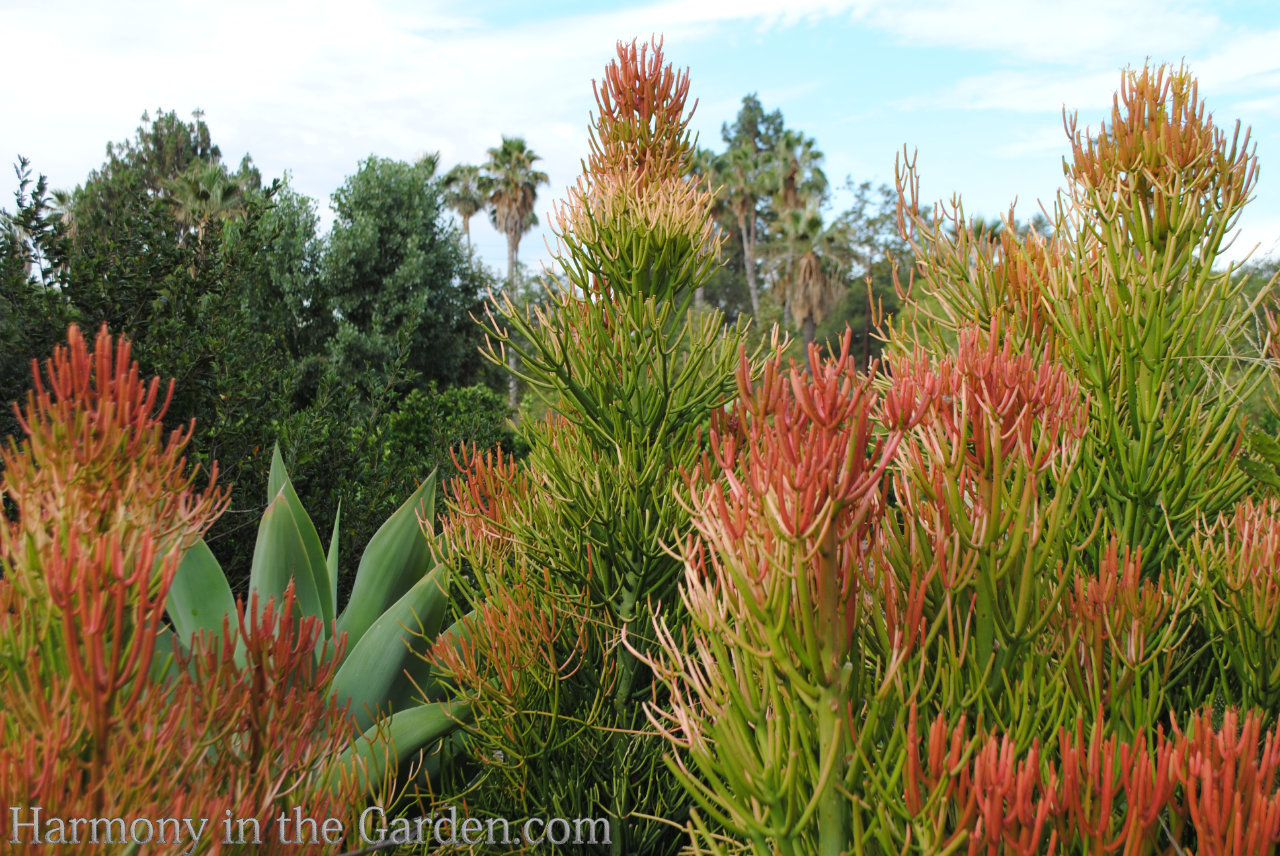
Euphorbia tirucallii (Sticks on Fire) zones 10-11
If my zone had slightly warmer winters I would 100% grow ‘Sticks on Fire’. But alas, the slightest frost tends to kill them.
It’s such an incredible succulent, and under ideal circumstances could grow up to 25 feet! Usually, though, it remains closer to 4-6 feet.
The pencil-like stems are yellow-green, but once the temperatures drop a bit will turn brilliant pink and orange colors.
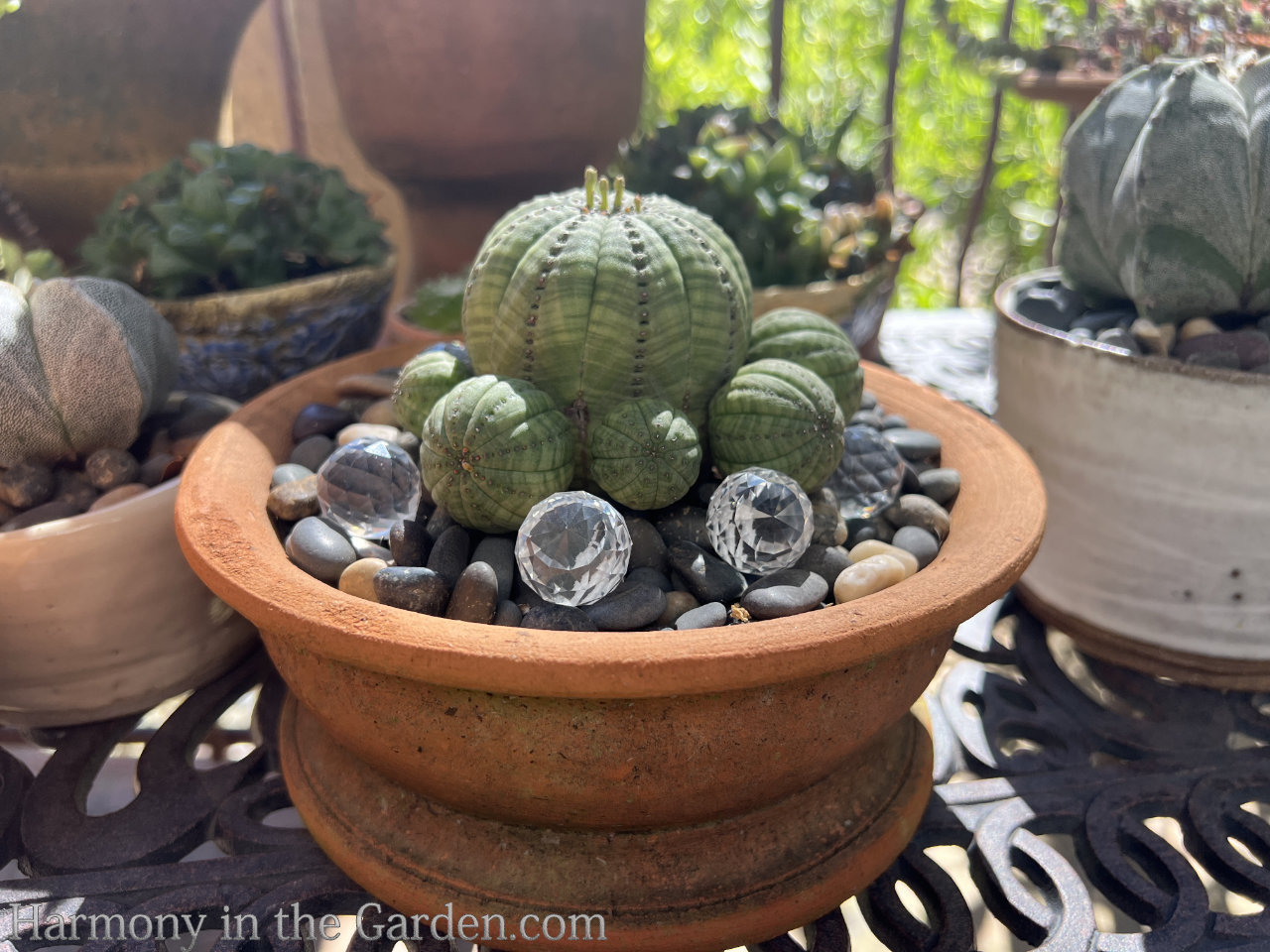
Euphorbia obesa (Baseball Plant) zones 9-11
I had to include my very favorite little succulent in the ‘Adding Motion’ section of this blog post because it’s naturally occurring shape looks like little bouncing balls.
I’ve had mine for about 10 years, and 4 years ago it developed these little ‘pups’ along it’s belt-line.
I keep waiting for them to fall off and re-root, but they’ve been like this for years and are so weird that I leave them be.
I love this little guy.
3. Add Contrasting Color
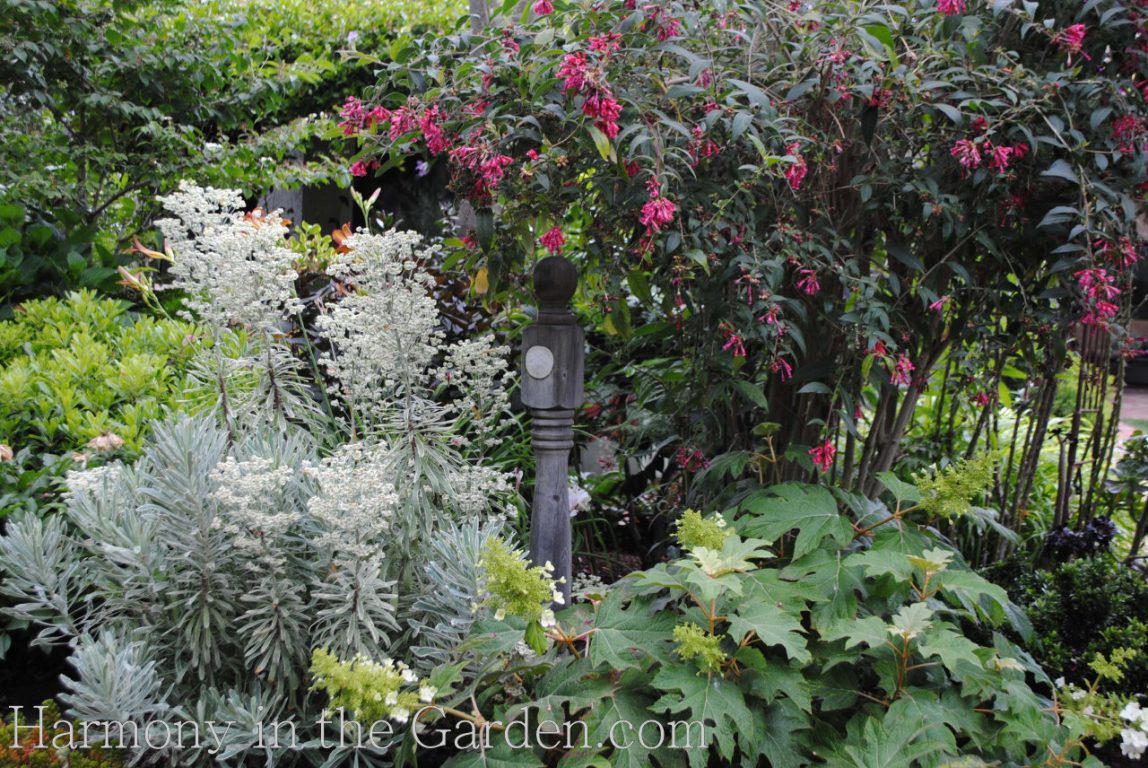
Euphorbia ‘Glacier Blue’ & ‘Tasmanian Tiger’, zones 7-9
Both varieties are variegated, with the ‘Tasmanian Tiger’ having more silver in the foliage. ‘Glacier Blue’ is much shorter (24″ vs. 3′) and has more blue-green variegation.
When variegated euphorbias are planted near others with dark green foliage, they provide a stunning visual contrast and add an exciting pop of color to your garden.
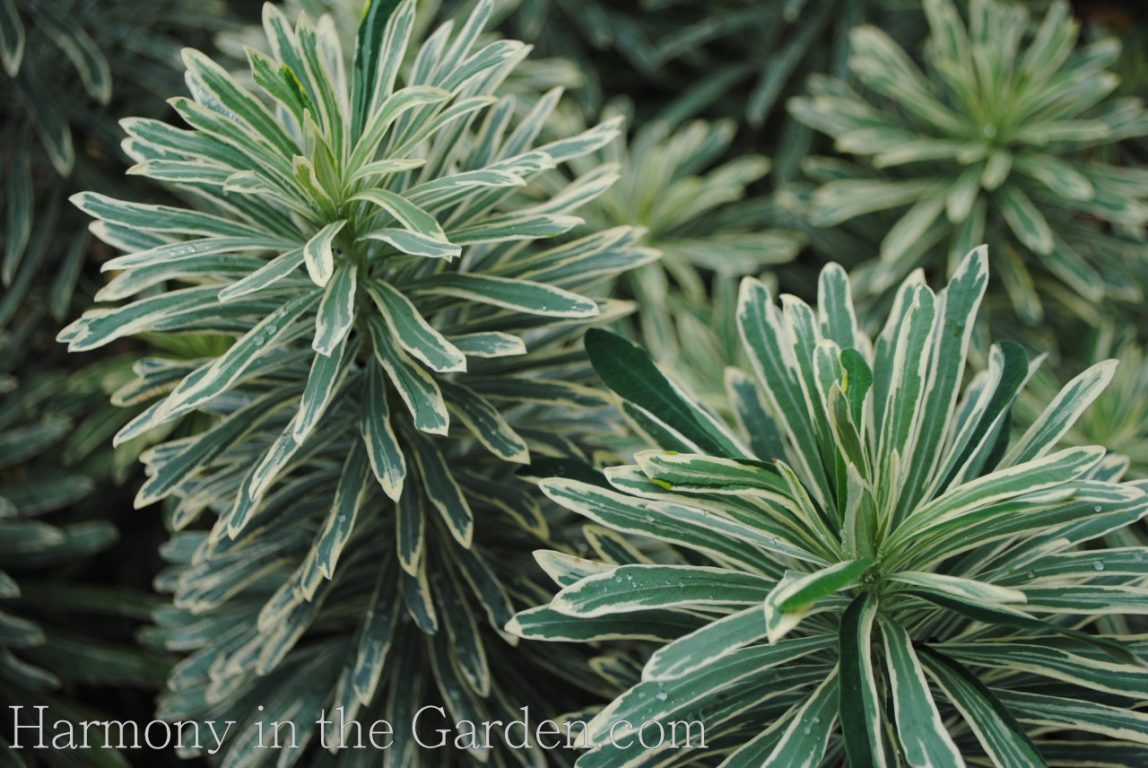
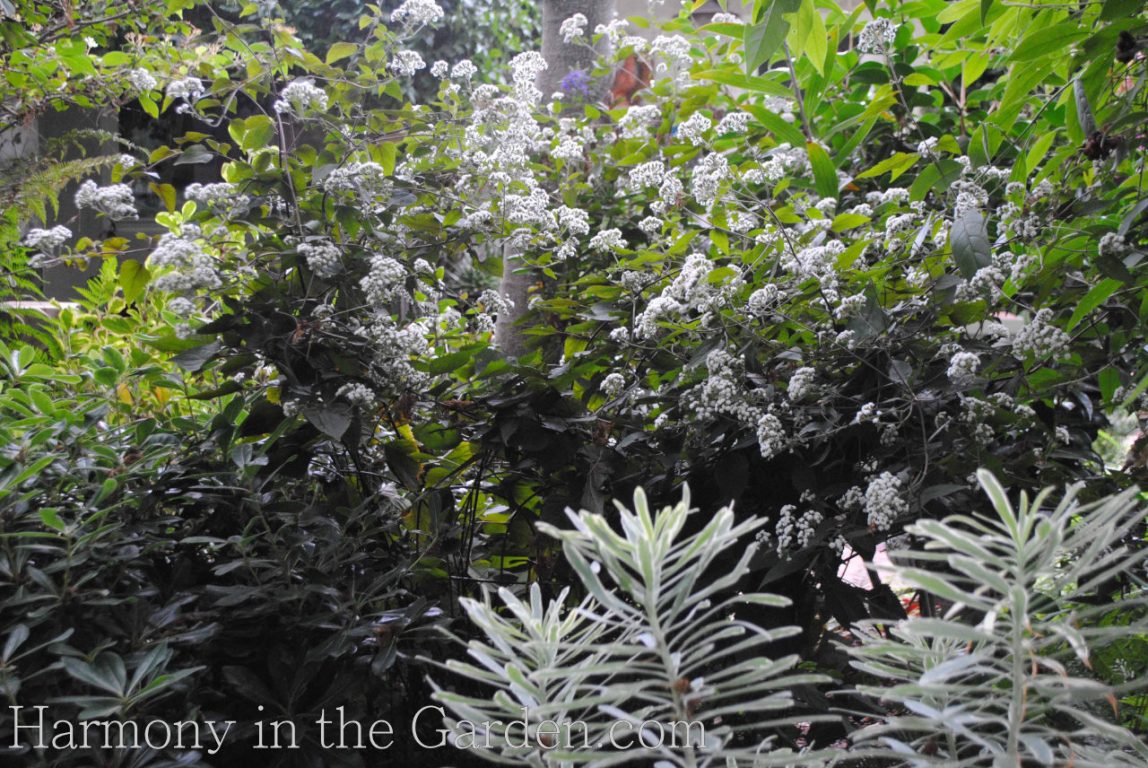
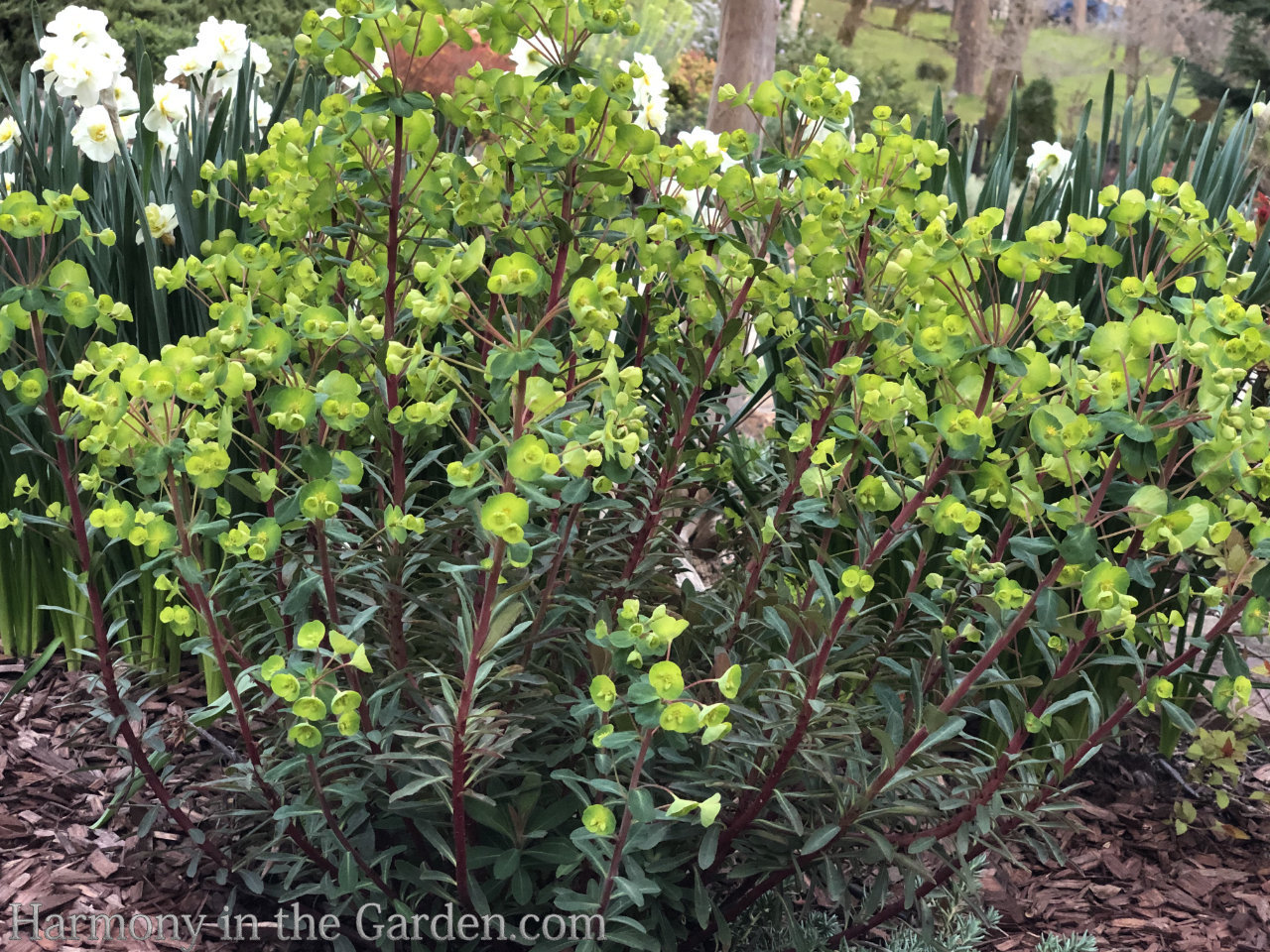
Euphorbia amygdaloides ‘Charam’/’Red Wing’ zones 7-9
An incredible variety for the front of the border is ‘Charam’ (also sold as ‘Red Wing.)
It grows to a tidy 2’x2′ mound with very compact blooms, but my favorite quality is the contrasting red stems.
I LOVE the bright green and deep red combo with the blue-ish tones in the foliage. A must-have, for sure.
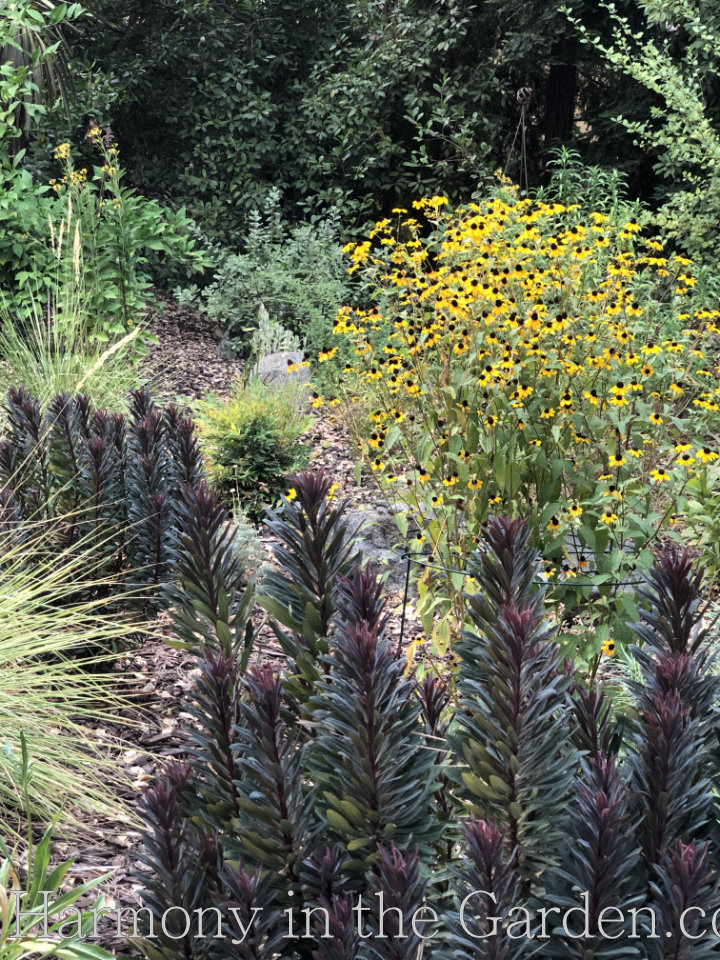
Euphorbia ‘Blackbird’ zones 6-10
‘Blackbird’ is actually a sport of euphorbia charam (above) and has some of the deepest, darkest burgundy foliage of all euphorbias (especially in full sun.)
It’s one of my favorites for adding moody drama to the garden.
This variety is particularly susceptible to root rot (as a result of too much water,) so make sure you have fast drainage!
The tag says it grows to 2’x2,′ but when it’s happy in full, baking hot sun, it can quickly reach 3’x3’.

Euphorbia characias ‘Wulfenii’ zones 7-10
I can’t write a post about euphorbias and not include the gorgeous blue foliage of ‘Wulfenii.’
A freely reseeding variety (which translates into ‘plant one and you’ll have them for life!’), I’ve seen ‘Wulfenii’ growing to a towering 4’x4′.
And once it’s covered with its chartreuse blooms in early spring, it’s the very definition of ‘show-stopper.’
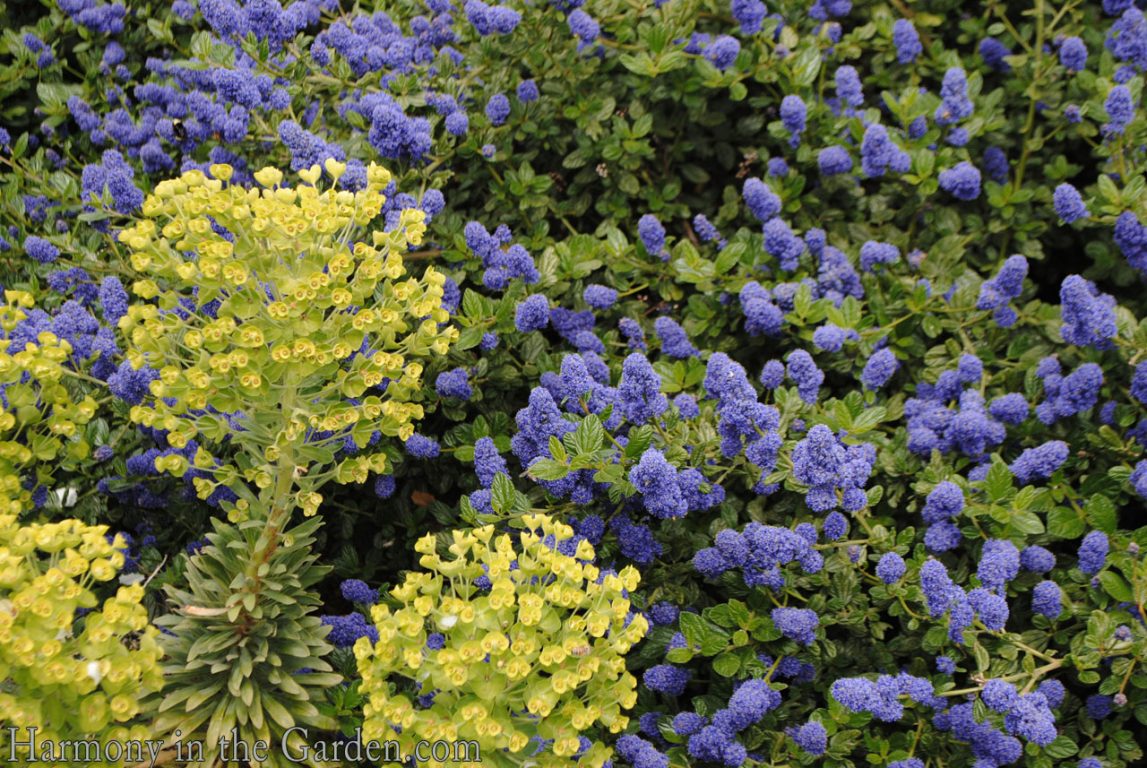
In fact, every spring, I seem to have at least one new client who tries to describe the most amazing plant they’ve ever seen…‘with Dr. Seuss-like chartreuse orbs!’ and I always immediately know what they’re referring to!
Doesn’t this ‘Wulfenii’ look incredible paired with the blue flowers of this ceanothus?

Euphorbia ceratocarpa, zones 8-10
While this variety’s foliage isn’t maroon, blue, or even variegated, I decided to put it in this category because of its fresh and bright green color (it’s the oversized plant with the acid-yellow blooms behind the brick wall.)
I love how the chartreuse flowers contrast with the burgundy foliage of the Japanese maple. (click here to read about the transformation of this area of my garden.)
It’s hands-down my very favorite euphorbia of all, not only because it’s perfect for waking up a hot and tired garden but because it is the longest blooming euphorbia I’ve ever seen.
More often than not, I’ll still have flowers on this plant in December!
It’s a biggie, quickly growing to an impressive 5’x5’ so make sure you give it enough room – the middle or back of the border is ideal.
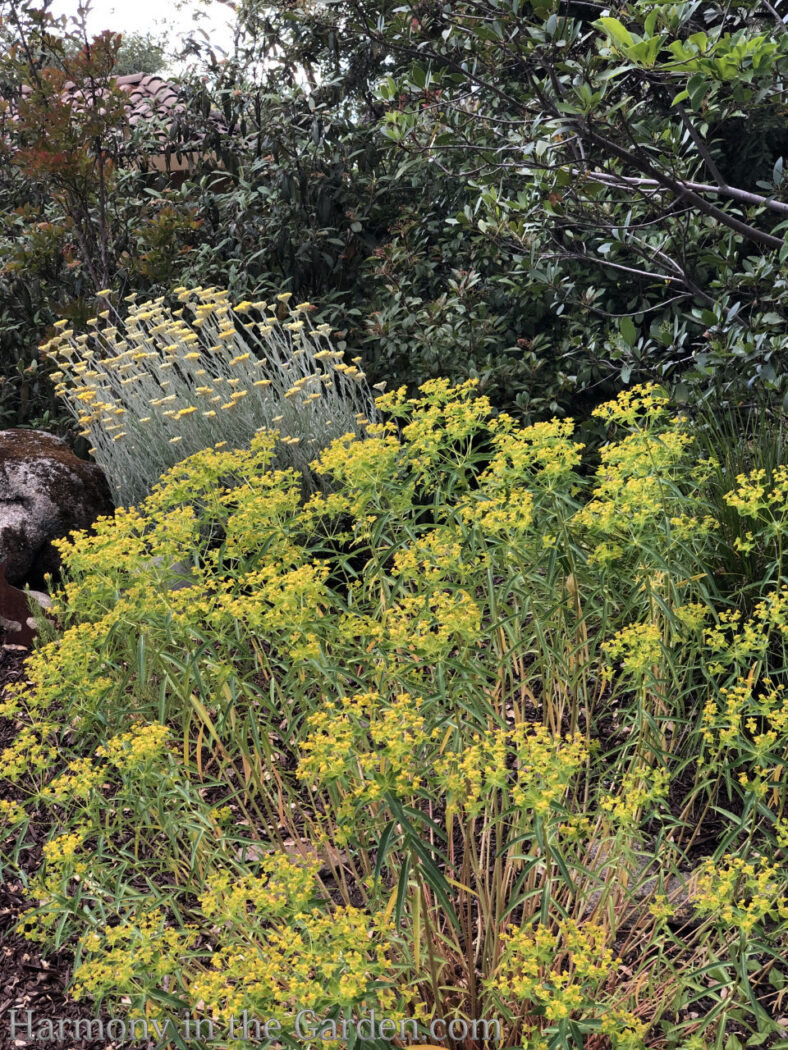
The foliage and flowers of the e. ceratocarpa are looser in form than some of the other varieties, giving it a light and airy quality.
The only downside is that it’s virtually impossible to find in the nurseries.
But luckily, you can easily propagate it via cuttings or by transplanting the occasional seedling that might appear.
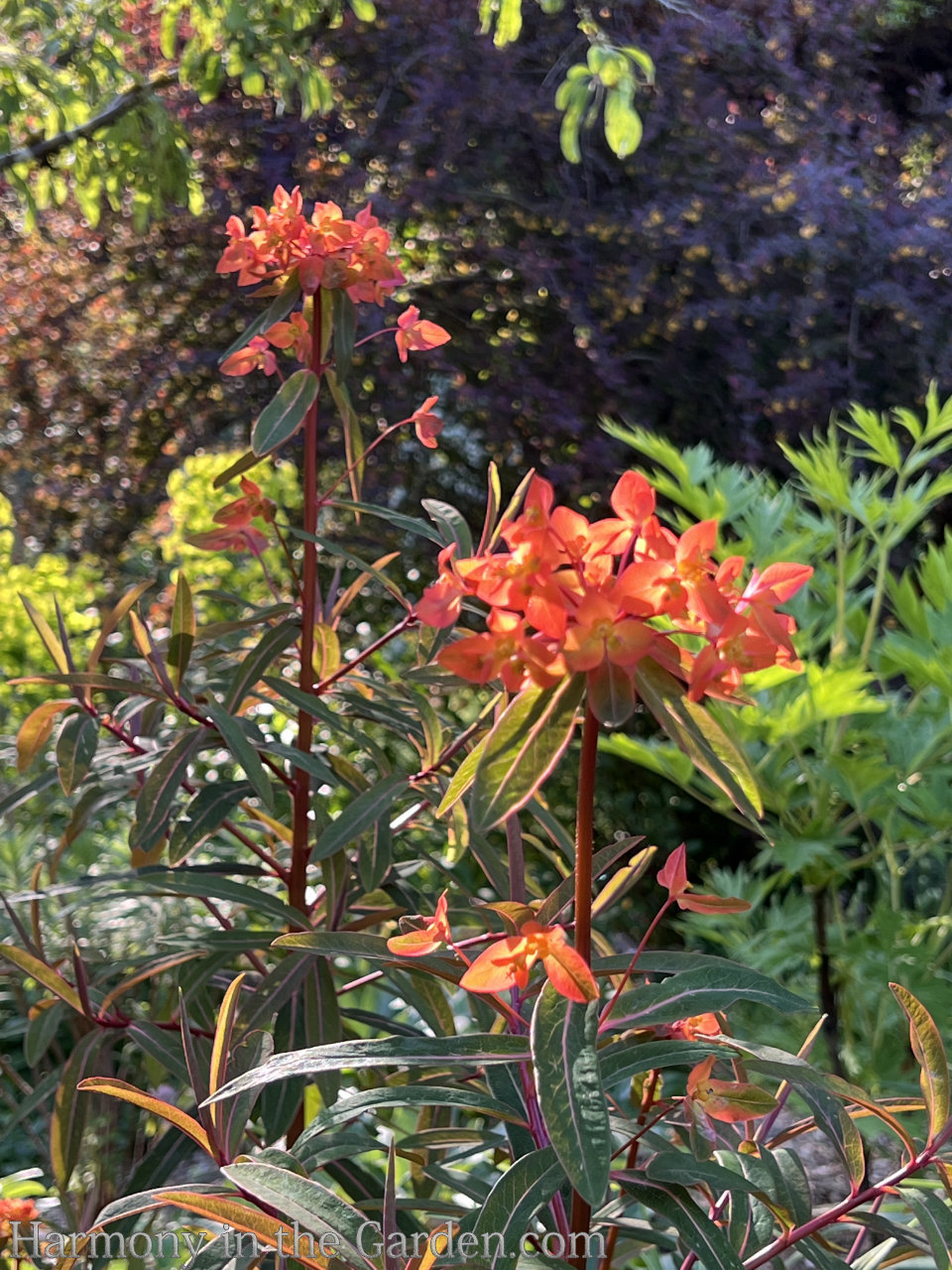
Euphorbia griffithii ‘Fireglow’ zones 4-8
Euphorbia griffithii ‘Fireglow’ is a beauty, isn’t it? So many euphorbias have bright yellow flowers, which makes ‘Fireglow’ a standout in the garden.
It’s burnt-orange flowers (which are actually called ‘bracts’) resemble torches on top of brick-red stems.
This variety wants more water than others, and when happy can quickly spread via rhizomes to form a 3’x3’ (or wider!) clump. Once the cooler temperatures of fall arrive, the foliage is tinged with crimson and yellow.
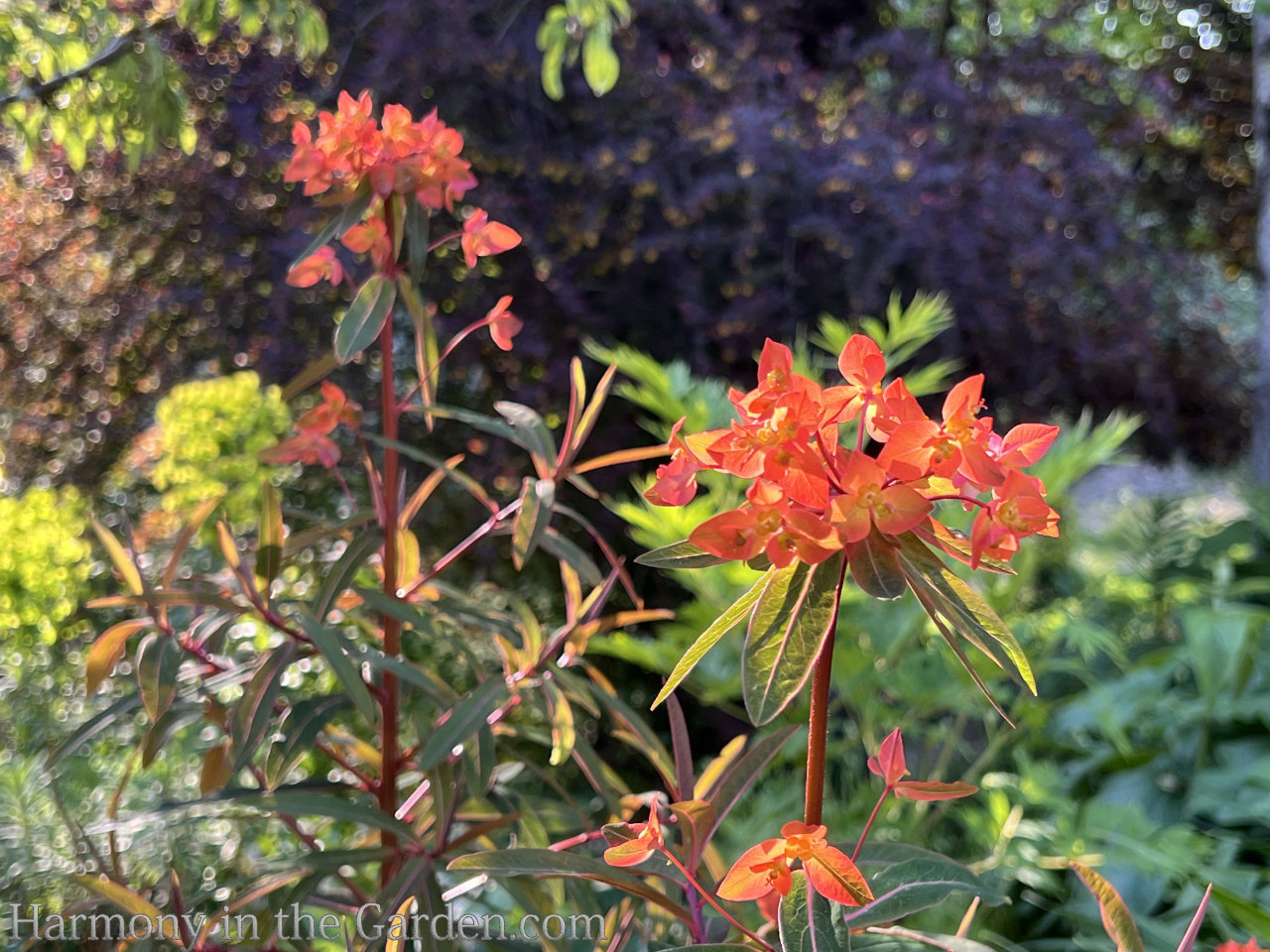

Euphorbia polychroma zones 4-8
One of my favorite euphorbias that thrives in our zone 6 Lake Tahoe garden, is the Cushion Spurge.
Reliably returning each spring, this euphorbia begins as a tidy 1’x1′ mound of vibrant blue-green foliage.
But within just a few weeks its topped with bright yellow, open flowers – an unusual shape compared to many other euphorbias.
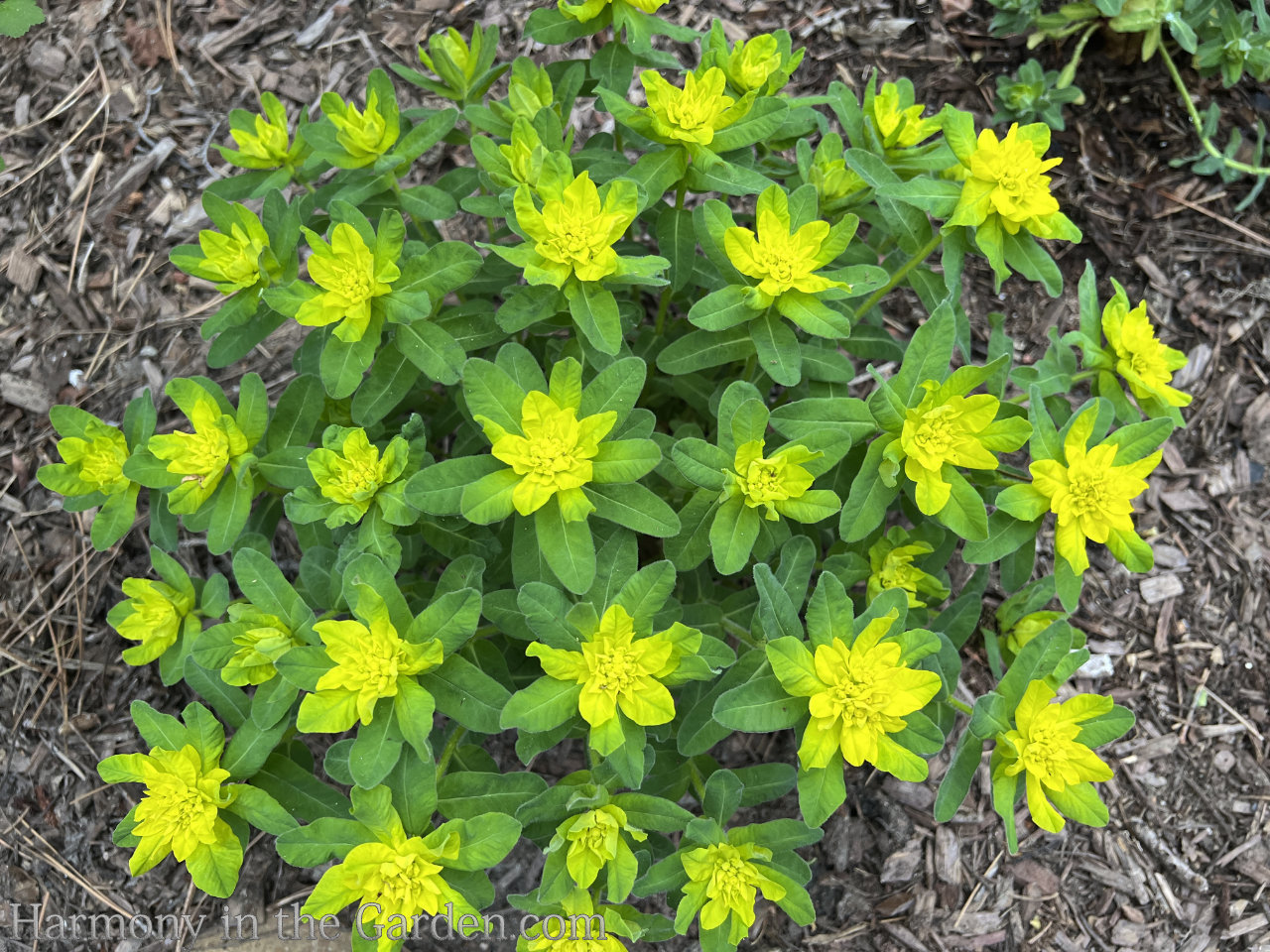
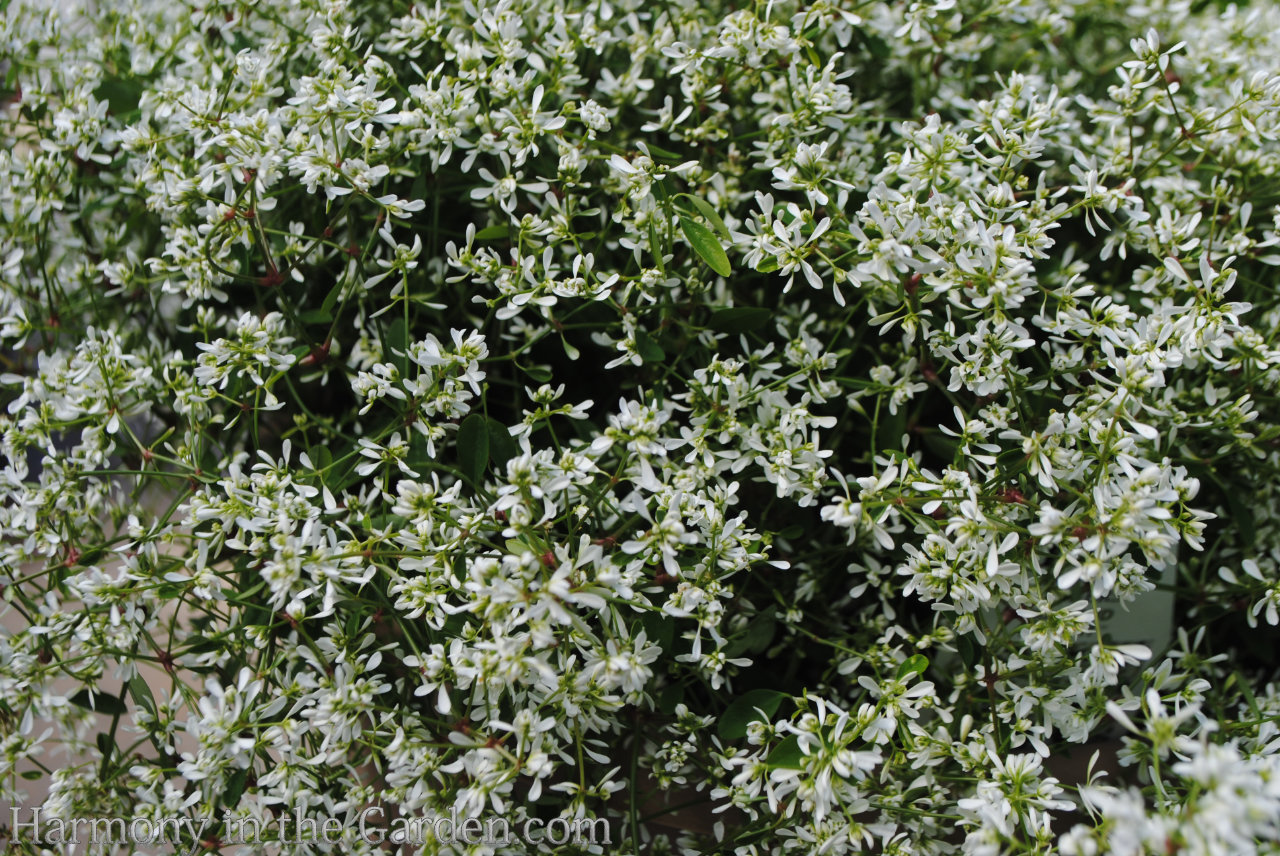
Euphorbia hypericifolia ‘Diamond Delight’ (annual)
While some call it a tender perennial, I’ve yet to keep it alive for more than a year, so I’m calling it an annual.
‘Diamond Delight’ is the most vigorous double flowering euphorbia on the market, and is literally covered with hundreds of tiny little white flowers on wiry, wispy stems.
The delicate, fine foliage and flowers are fantastic when combined with the velvety, gray foliage of a ‘Silver Carpet’ lambs ears, and grows to a tidy 1’x1′ mound.

Be forwarned!
I’d be remiss if I didn’t mention that all euphorbia stems leak a thick white sap that may cause rashes or blisters in some people.
I’m knocking on wood as I write this, but I’ve been planting euphorbias in gardens for 20 years, and the sap has yet to cause any problems for me.
However, I definitely wouldn’t plant them where young children would be tempted to pick a bouquet of flowers.
So consider yourself warned – they’re gorgeous but they can be nasty, so handle with caution!
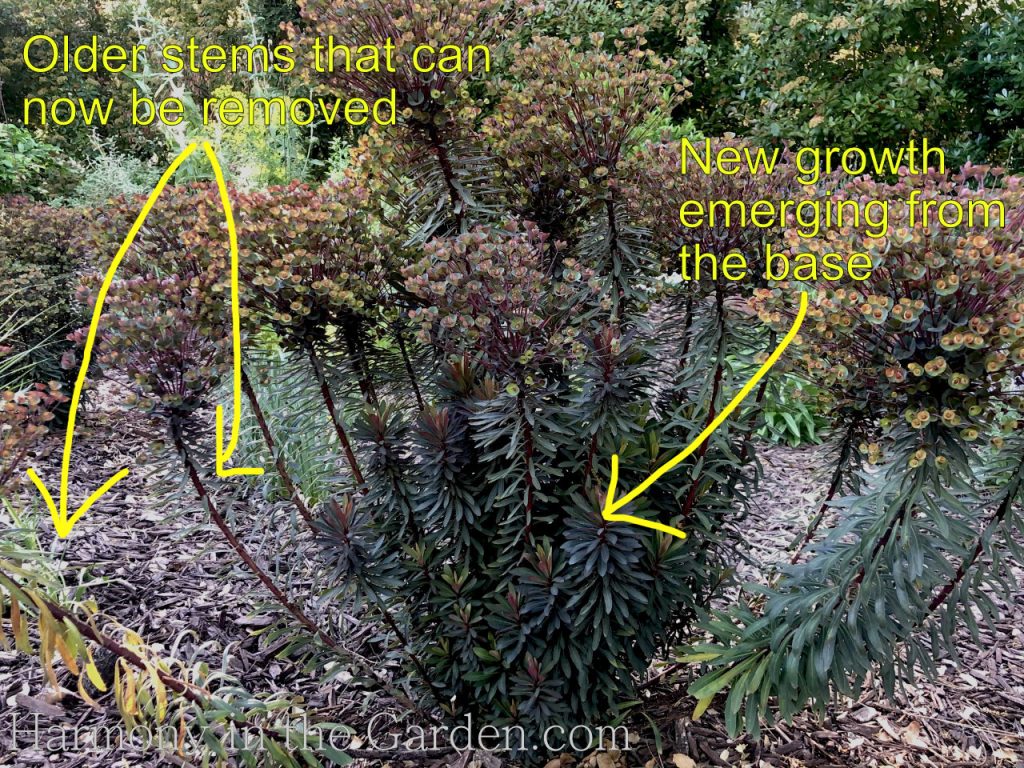
Pruning
I’m often asked how and when to prune euphorbias.
Once the flowers start to turn a light tan color, it’s time to cut them back a bit.
Instead of cutting everything to the ground in one solid swoop (in a bad haircut sort of way), I prefer to selectively remove some of the old stalks, a few at a time, over the course of a few weeks.
If you prune it this way, your plant will look good for most, if not all, of the year.
Have I left any of your favorite varieties out? If so, please let me know – I’m always on the hunt for another one to try in my garden!





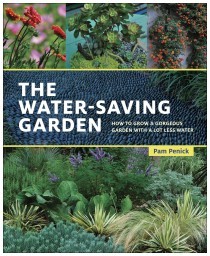
18 Comments
Thank you for this Rebecca. I never knew there were so many varieties! Also, what a great idea for a window box!
You’re so welcome, Jim – you should definitely try them in your hot and sunny garden!
Wow! What an amazing education in using new plant combinations! I always learn so much about plants from reading your blog!
I also have window boxes, but haven’t been especially creative with them! I have one on the 2nd story that gets a lot of direct sun and wind, so it’s a challenge to plant it. Currently it has tough trailing geraniums in it, which are not especially creative, but seem to handle the environment! I’ll have to re-think my options using succulents.
Always so fun and interesting to read your blog!!
What a nice thing to say, Ronnie – thank you!! Direct sun is definitely a challenge and geraniums are a great choice. You might be able to combine them with succulents and/or euphorbias as they’ll do really well in the sun. If it’s a crazy amount of sun, the succulents might burn, so keep an eye out. But the euphorbia myrsinites will be in heaven (the more sun, the better!) A dwarf aloe would be really cute, too (especially when they bloom)
It was so nice to visit with you, Linda – you always make me laugh and smile! Maybe one of these days I’ll wind up in YOUR backyard – wouldn’t that be fun!!!???
I don’t believe you at all, Laura! I’ve personally heard from others (Debra included!) that your garden is stunning! One of these days I must see it in person!! 🙂
Loved seeing you, too, Dee. I’m just so sorry we were practically melting during our visit!! 😉
I so enjoyed this article. I too love euphorbias but haven’t yet used them as much as I would like; your photos are great inspiration. Have you used Lomandra in your plantings? It seems a plant that would be right up your alley. I recently picked up a couple new ones at Green Acres (new to me anyway) and am having fun pairing them with tried and true favorites. Lomandra ‘Miner’s Gold’ color echoing Coleonema ‘Sunset Gold’ and I am going to find an euphorbia for that pairing. Lomandra ‘Arctic Frost’ is similar to Platinum Beauty but has livelier coloring that I plan to pair with lambs ears and Artemisia. I will definitely be on the lookout for more euphorbias. The poor deer will have to munch elsewhere.
Hi Mary, I’m so glad you enjoyed my euphorbia article. They’re fantastic for our area, as are lomandras (which I also adore and use extensively) You might like the euphorbia ‘Ascot Rainbow’ combined with your lomandra ‘Miner’s Gold’, which would echo the lovely gold/chartreuse colors. And for contrast, perhaps a ‘Miner’s Merlot’ euphorbia (if you like deep burgundy colors as much as I do!) Your combinations sound beautiful (so sorry deer and gophers – move along!) Happy Holidays!
Hi Jayne! I’m glad you enjoyed my garden – and for the heads-up that my garden was written about on another blog. What a nice surprise! Some euphorbias are definitely hardier than others, so I hope you find a few that are hardy in your area. The little ‘Ascot Rainbow’ is so beautiful in a container or window-box, maybe you’ll have better luck there than planting in the ground? Fingers crossed for you! 🙂
Hi Brent – ha! I can only imagine the hell you were in out there. Truly, one of the most miserable weekends of weather we’ve had in a long time!!
Thanks Diane! Those little ladybugs were eating the buffet of aphids that were all over my plants. Fat and happy, for sure!
Hi Sabrina – so glad to hear your tour went well! (though that doesn’t surprise me at all – who wouldn’t love your garden!!)
Thanks so much, Kris! I’ve tried Dean’s Hybrid a couple of times and I must be doing something wrong because I’ve killed both of them. 🙁 You’re right – it’s so beautiful with its ferny foliage – very different than the others. Maybe I’ll try again – third times a charm, right? And if its any consolation, while the Bloggers Fling was fantastic, it was a steamy 95 degrees in my garden. VERY hot!
Those pesky re-seeders (I think ‘Wulfenii’ is the worst, don’t you?) are definitely something to think about when planting. Every year I have the Wulfenii popping up everywhere. But I’m thinking the Ascot Rainbow isn’t as prolific? I haven’t had any reseed in my garden – yet. And I haven’t had any ‘Blackbirds’ reseed either. And you’re right – who needs roses and annuals. ha! I sure with you were coming, Sheila. Even though you’re not a blogger, we’d definitely have fun!!!
I’m really looking forward to meeting you in person, Alison! Hopefully it won’t be too hot this weekend – I’ll make sure to have plenty of iced tea for everyone. 🙂
Hi Sue, Thank you so much for the kind words. They mean a lot to me. I’m sorry your roses have taken such a beating. Mine are just limping along this year – except for my Fourth of July and Sally Holmes. Nothing stops those two! And yes, my new book will certainly help you deal with an aging garden, giving it a little ‘oomph’. I wish you were joining the bloggers as well – I could send you home with a few euphorbia seedlings!
You’re so welcome, Jo! Hmmm…I’m thinking the twirly one might look nice cascading around the base of your new rose arbor?